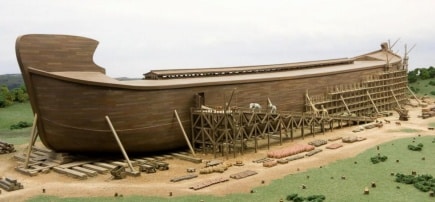One issue that is often raised against Christianity is Noah’s Ark and the Flood. Did it really happen? Did the flood really cover the whole world? Is there enough water on earth to cover all the land? Could the ark really hold two of every kind of animal in the world? Though these might be intimidating questions, the answer to each is a resounding, “Yes.”

God said to Noah in Genesis 6:14–16, “Make for yourself an ark of gopher wood; you shall make the ark with rooms, and shall cover it inside and out with pitch. 15 “This is how you shall make it: the length of the ark three hundred cubits, its breadth fifty cubits, and its height thirty cubits. 16 “You shall make a window for the ark, and finish it to a cubit from the top; and set the door of the ark in the side of it; you shall make it with lower, second, and third decks.” According to God’s Word, Noah built the ark. Eight people entered it and all humanity died in the ensuing flood.
Did the flood really happen? Yes. Jesus said in Matt. 24:37-39 that the flood happened.
Matthew 24:37–39, “For the coming of the Son of Man will be just like the days of Noah. 38 “For as in those days before the flood they were eating and drinking, marrying and giving in marriage, until the day that Noah entered the ark, 39 and they did not understand until the flood came and took them all away; so will the coming of the Son of Man be.”
As far as physical evidence goes there are numerous sedimentary deposits worldwide which suggest a universal flood. There are countless fossil deposits world-wide (fossilization occurs when organisms are buried rapidly within sediment). Every major culture has a flood legend. Of over 200 flood legends, 95% say the flood was universal; 70% say survival depended upon a boat; 66% say the wickedness of man was the cause; 88% say there was a favored family; 66% say the remnant was warned; 67% say animals were also saved; 57% say the survivors ended up on a mountain; 35% say birds were sent out; 9% say eight people were saved; and 7% mention a rainbow.
Is there enough water to flood the entire earth? Absolutely! If the earth were perfectly spherical the oceans would cover all the land by more than a mile in depth. The biblical account is that it rained for 40 days and nights in which the floodgates of the heavens were opened up as well as the fountains from the earth (Gen. 7:11;8:2). There is a theory known as the canopy theory that states it had never rained on the earth up to the time of Noah and that a mist watered the plants (Gen. 2:6). The theory goes on to state that there may have been a heavy cloud or water vapor layer over the entire earth and that it was this canopy of water that became torrential rains during the flood period.
Did the flood cover all the earth? Yes, it did. The depth of the floodwaters is described in Gen. 7:19 as covering “all the high mountains under the entire heavens.” Also, there are many references in the Bible to it being global: Gen. 6:1,4-5,12,13,17,19;7:4,6,10,19;8:3;9:15. There were 40 days of rain (Gen. 7:12), 110 days of flooding (Gen. 7:24), and 221 more days of draining (Gen. 8:1-5,13-14). That is a total of 371 days of flooding. That could not be a local flood.
Could the ark really contain all the animals of the world? Again the answer is “Yes.” But let’s look at the last question in more detail. The ark took about 120 years to build. Noah was 480 years old when he began the work and he had the help of his wife, three sons, and his son’s wives. He probably hired local people to help in the construction.
The dimensions of the ark have a ratio of six to one. The Ark was six times longer than it was wide. This is the best ratio for modern shipbuilding. Model stability tests have shown that the design is stable for waves up to 200 feet high and that the ark could have rotated 90 degrees and still righted itself.
The volume of the ark would be 450 feet long by 75 feet wide by 45 feet high. This equals 1,518,750 cubic feet and is comparable to 569 modern railroad boxcars. Therefore each boxcar, by comparison, would be 1,518,750 divided by 569, or 2,669 cubic feet of space. The average size of an animal on the earth is smaller than a cat. But, just to keep it safe let’s consider the average size of an animal to be a sheep. The average double-deck stock car holds 240 sheep. The Ark capacity would be about 569 x 240 equaling 136,560 animals of that size. However, that still is not accurate for our needs. Since most birds, reptiles, and amphibians are much smaller, let’s double the boxcar capacity for them. Therefore, the boxcars could each hold 480 different kinds of birds, reptiles, amphibians.
Noah had to take two or seven of every kind of animal on the earth. Though it is not really known exactly what is meant by a biblical kind, it is generally considered to be animals that are fertile within their own groups. Any dog can breed with any dog, therefore, dogs are one kind. It would only be necessary to bring representatives of each kind since the parents could produce offspring that would carry the genetic information for all variations within their kind.
| Classification | Number of Species |
Number of Kinds on the Ark |
| Mammals Birds Reptiles Amphibians Fishes Other marine life Insects |
3,700 8,600 6,300 2,500 20,600 192,605 850,000 |
3,700 (a few live in water) 60,200 (seven pairs according to Gen. 7:3) 6,300 2,500 zero zero (Since insects are very small, and a great many could be stored in a small area, the calculation would be difficult.) |
| Total | 1,072,305 | 72,700 |
The total number of mammals would be 3,700 times two pairs which equals 7,400 animals. 7,400 divided by 240 = 31 boxcars used.
Since Gen. 7:3 says to take seven pairs of every bird then the total for birds would be 8,600 times two pair times 7 or 120,400 animals. 120,400 x 480 = 250 boxcars. The reptiles and amphibians would be 6,300 plus 2,500 or 8,800. 8,800 times two pairs equals 17,600 animals. 17,600 divided by 480 = 37 boxcars.
The total number of boxcars used would be 318 with the total number of animals at 145,400. There would be 251 boxcars left over. That means that only 56% of the ark would be used for storing the animals. Obviously, then, the rest of the space would be used for food for the people and animals and sleeping quarters. In addition, considering that insects are extremely small, it is easily conceivable that they could be housed in part of the remaining space.
It should also be considered that many animals can hibernate. Additionally, predators and prey have been known to live peacefully together during situations of stress like fire, flood, or earthquake. In the Ark, animal behavior probably would have been different from normal daily life. Specialists in animal behavior have noted that animals can sense danger and have often migrated to escape it. Perhaps God used their migratory instincts to get them to the Ark.
Though this is only a brief analysis, it should present enough evidence that the Ark account is certainly within the realm of possibility.






